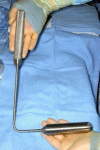Assessment of the durability of robot-assisted laparoscopic sacrocolpopexy for treatment of vaginal vault prolapse
- PMID: 25484955
- PMCID: PMC4247457
- DOI: 10.1007/s11701-007-0028-8
Assessment of the durability of robot-assisted laparoscopic sacrocolpopexy for treatment of vaginal vault prolapse
Abstract
Transabdominal sacrocolpopexy has been shown, in multiple long-term studies of its success and durability, to be the definitive treatment option for post-hysterectomy vaginal vault prolapse. It is, however, associated with greater morbidity than vaginal repair. We describe a minimally invasive technique for vaginal vault prolapse repair and present our experience with a minimum of one-year follow-up. The surgical technique involves five laparoscopic ports-three for the da Vinci robot and two for the assistant. After appropriate dissection a polypropylene mesh is attached to the sacral promontory and to the vaginal apex by use of Gore-Tex sutures. The mesh material is then covered by the peritoneum. Patient analysis focused on complications, urinary continence, patient satisfaction, and morbidity, with a minimum of 12 months follow-up. Forty-two patients with post-hysterectomy vaginal vault prolapse underwent robot-assisted laparoscopic sacrocolpopexy at our institute and 35 have a minimum of 12 months follow-up, with a mean follow-up of 36 months (range 12-48) in the group. Mean age was 67 (47-83) years and mean operating time was 3.1 (2.15-4.75) h for the entire cohort. All but one patient were discharged home on postoperative day one; one patient left on postoperative day two. One developed recurrent grade three rectocele, one had recurrent vault prolapse, and two suffered from vaginal extrusion of mesh. All patients were satisfied with their outcome. The robot-assisted laparoscopic sacrocolpopexy is a minimally invasive technique for vaginal vault prolapse repair, combining the advantages of open sacrocolpopexy with the reduced morbidity of laparoscopy. We observed reduced hospital stay, low occurrence of complications, and high patient satisfaction, with a minimum of 1-year follow-up. Most importantly, the long-term results of the robotic repair are similar to those of open repair, but with significantly less morbidity.
Keywords: Laparoscopy; Robotics; Sacrocolpopexy; Vaginal vault prolapse.
Figures




Similar articles
-
Long-term results of robotic assisted laparoscopic sacrocolpopexy for the treatment of high grade vaginal vault prolapse.J Urol. 2006 Aug;176(2):655-9. doi: 10.1016/j.juro.2006.03.040. J Urol. 2006. PMID: 16813916
-
[Management of vaginal vault prolapse repair with robotically-assisted laparoscopic sacrocolpopexy].Ann Urol (Paris). 2007 Feb;41(1):31-6. doi: 10.1016/j.anuro.2006.12.001. Ann Urol (Paris). 2007. PMID: 17338498 French.
-
Gynecologic use of robotically assisted laparoscopy: Sacrocolpopexy for the treatment of high-grade vaginal vault prolapse.Am J Surg. 2004 Oct;188(4A Suppl):52S-56S. doi: 10.1016/j.amjsurg.2004.08.022. Am J Surg. 2004. PMID: 15476652
-
Transabdominal approach to repair of vaginal vault prolapse.Tech Urol. 2001 Jun;7(2):139-45. Tech Urol. 2001. PMID: 11383992 Review.
-
[Abdominal sacrocolpopexy--simple and still actual method in the treatment of vaginal vault prolapse?].Ceska Gynekol. 2008 Jan;73(1):47-53. Ceska Gynekol. 2008. PMID: 18411642 Review. Czech.
Cited by
-
Robot-assisted surgery:--impact on gynaecological and pelvic floor reconstructive surgery.Int Urogynecol J. 2012 Sep;23(9):1163-73. doi: 10.1007/s00192-012-1790-3. Epub 2012 May 26. Int Urogynecol J. 2012. PMID: 22638668 Review.
-
Robotic and laparoscopic sacrocolpopexy for pelvic organ prolapse: a systematic review and meta-analysis.Ann Transl Med. 2021 Mar;9(6):449. doi: 10.21037/atm-20-4347. Ann Transl Med. 2021. PMID: 33850846 Free PMC article.
-
Long-term mesh erosion rate following abdominal robotic reconstructive pelvic floor surgery: a prospective study and overview of the literature.Int Urogynecol J. 2020 Jul;31(7):1423-1433. doi: 10.1007/s00192-019-03990-1. Epub 2019 Jun 20. Int Urogynecol J. 2020. PMID: 31222568 Free PMC article. Review.
-
Chronic Pelvic Pain, Quality of Life, and Patient Satisfaction After Robotic Sacrocolpopexy for Pelvic Organ Prolapse.Cureus. 2022 Aug 17;14(8):e28095. doi: 10.7759/cureus.28095. eCollection 2022 Aug. Cureus. 2022. PMID: 36127971 Free PMC article.
-
Current trends and future perspectives in pelvic reconstructive surgery.Womens Health (Lond). 2018 Jan-Dec;14:1745506518776498. doi: 10.1177/1745506518776498. Womens Health (Lond). 2018. PMID: 29772955 Free PMC article. Review.
References
-
- Marchionni M, Bracco GL, Checcucci V, Carabaneanu A, Coccia EM, Mecacci F, et al. True incidence of vaginal vault prolapse. Thirteen years of experience. J Reprod Med. 1999;44:679. - PubMed
-
- Dwyer PL, Lee ETC, Hay DM. Obesity and urinary incontinence in women. Br J Obstet Gynaecol. 1988;95:91. - PubMed
LinkOut - more resources
Full Text Sources
Miscellaneous

